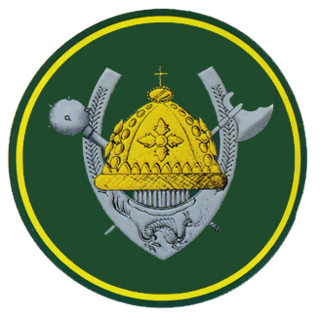Related Research Articles

The 1st Guards Army was a Soviet Guards field army that fought on the Eastern Front during World War II.
The 18th Army of the Soviet Union's Red Army was formed on 21 June 1941 on the basis of HQ Kharkov Military District and armies of the Kiev Special Military District.
The 75th Guards Rifle Division was a Red Army infantry division during World War II and afterwards, which later became the 75th Guards Tank Division and was finally disbanded in the 1990s.

The 20th Guards Combined Arms Army is a field army. In 1991, after the dissolution of the Soviet Union, the army became part of the Russian Ground Forces.
The 2nd Shock Army was a field army of the Soviet Union during the Second World War. This type of formation was created in accordance with prewar doctrine that called for Shock Armies to overcome difficult defensive dispositions in order to create a tactical penetration of sufficient breadth and depth to permit the commitment of mobile formations for deeper exploitation. However, as the war went on, Shock Armies lost this specific role and reverted, in general, to ordinary frontline formations.

The 3rd Guards Tank Army was a tank army established by the Soviet Union's Red Army during World War II. The 3rd Tank Army was created in 1942 and fought in the southern areas of the Soviet Union and Poland, then in Germany and Czechoslovakia until the defeat of Germany in 1945. Postwar, the army served as occupation troops in East Germany, went through several name changes, and was finally deactivated in 1969.

The 11th Guards Army was a field army of the Red Army, the Soviet Ground Forces, and the Russian Ground Forces, active from 1943 to 1997.
The 3rd Guards Volnovakha Red Banner Order of Suvorov Motor Rifle Division was a division of the Soviet Army from 1957 to around 1992. It traced its history from the highly decorated 3rd Guards Rifle Division of World War II. The 3rd Guards Rifle Division was formed from the 153rd Rifle Division.
The 27th Army was a field army of the Soviet Union's Red Army, which fought in World War II.

The 36th Army was a military formation of the Red Army and the Soviet Ground Forces, formed twice.

The 4th Guards Airborne Division was an airborne division of the Red Army that fought as infantry during World War II.
The 37th Army was an Army-level formation of the Soviet Union during the Second World War. The army was formed twice during the war. The army was part of the Southern Group of Forces in Romania and Bulgaria.
The 34th Guards Rifle Division was a rifle division of the Red Army during World War II.
The 6th Guards Airborne Division was a Red Army airborne division that fought as infantry during World War II.
The 32nd Guards Tank Division was a tank formation of the Soviet Army/Soviet Ground Forces. Its predecessor, the 9th Guards Airborne Division, was a Red Army Airborne division of World War II. On 19 June 1945, it became the 116th Guards Rifle Division. In 1946, it became the 14th Guards Mechanized Division. In 1957, it became the 14th Guards Motorized Rifle Division. In 1982, it became the 32nd Guards Tank Division, which was disbanded in June 1989.
The 38th Guards Airborne Corps was an airborne corps of the Soviet airborne. It was activated during World War II in August 1944 and became a rifle corps in December of that year. The corps fought in the Vienna Offensive and the Prague Offensive during the spring of 1945. After the end of the war, it was converted back into an airborne corps. The corps served at Tula until its 1955 disbandment when the Soviet airborne was reorganized.
The 12th Guards Rifle Corps was a corps of the Soviet Union's Red Army. Formed in 1942, the corps fought in the Vistula–Oder Offensive, East Pomeranian Offensive and Berlin Offensive. The corps was awarded the Order of the Red Banner for its actions during the storming of Berlin. It was disbanded in Germany in June 1946.
The 67th Army was a field army of the Soviet Union's Red Army. The 67th Army was formed in October 1942 on the Leningrad Front from the Neva Operational Group. It defended the right bank of the Neva River, holding the Nevsky Pyatachok and covering the Road of Life. In January 1943 the army fought in Operation Iskra. In late December, the army was combined with 55th Army. The 67th Army headquarters was disbanded and 55th Army headquarters was renamed 67th Army headquarters. Between January and March 1944 67th Army fought in the Leningrad–Novgorod Offensive, in which it captured Mga and Luga. In April the army became part of the 3rd Baltic Front and fought in the Pskov-Ostrov Offensive in July and the Tartu Offensive in August and September. The army fought in the Riga Offensive in September and October. The army then fought to eliminate the Courland Pocket. After the end of the war the army was disbanded during the summer of 1945.
The 82nd Rifle Corps was a rifle corps of the Red Army and later the Soviet Army.
The 4th Guards Motor Rifle Division was a motorized infantry division of the Soviet Army during the Cold War.
References
- ↑ Feskov et al 2013, p. 423
- Feskov, V.I.; Golikov, V.I.; Kalashnikov, K.A.; Slugin, S.A. (2013). Вооруженные силы СССР после Второй Мировой войны: от Красной Армии к Советской[The Armed Forces of the USSR after World War II: From the Red Army to the Soviet: Part 1 Land Forces] (in Russian). Tomsk: Scientific and Technical Literature Publishing. ISBN 9785895035306.